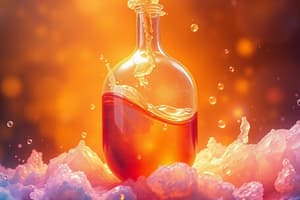Podcast
Questions and Answers
Which of the following methods can be used to separate a mixture based on particle size?
Which of the following methods can be used to separate a mixture based on particle size?
- Filtration (correct)
- Chromatography
- Centrifuging
- Magnetism
What is true about homogeneous mixtures?
What is true about homogeneous mixtures?
- They are composed of chemically bonded elements.
- They can contain only one substance.
- They can be separated by filtration.
- They have a uniform composition throughout. (correct)
Which of the following is an example of a physical property?
Which of the following is an example of a physical property?
- Reacts with acids
- Density (correct)
- Reacts with O2
- Burns
What does the Law of Constant Composition state?
What does the Law of Constant Composition state?
Which prefix means $10^{-3}$ in the metric system?
Which prefix means $10^{-3}$ in the metric system?
Flashcards
Mass
Mass
The amount of matter in an object.
Mixture
Mixture
A combination of two or more pure substances that are not chemically bonded.
Distillation
Distillation
A technique that separates mixtures based on the different boiling points of the components.
Physical Property
Physical Property
Signup and view all the flashcards
Density
Density
Signup and view all the flashcards
Study Notes
Matter and Mixtures
- Matter has mass and occupies space (volume).
- Matter can be categorized as either a pure substance or a mixture.
- Pure substances are further classified into elements and compounds.
- Mixtures are combinations of two or more pure substances not chemically bonded.
Mixture Separation Methods
- Filtration: Separates mixtures based on particle size differences.
- Distillation: Separates mixtures based on differences in boiling points.
- Centrifuging: Separates mixtures based on differing densities.
- Magnetism: Separates magnetic materials (iron, cobalt, nickel).
- Chromatography: Separates mixtures based on differences in polarity.
Properties of Matter
- Physical Properties: Characteristics that describe a substance without changing its identity.
- Examples: taste, smell, molar mass, density, melting point, boiling point, freezing point.
- Chemical Properties: Describe a substance's reactivity with other substances.
- Examples: reactivity with oxygen, acids, bases; ability to burn.
Density
- Density is calculated as mass divided by volume (D = m/v).
Compounds
- A compound is formed when two or more different elements chemically bond together.
- The Law of Constant Composition states that a specific compound always contains the same elements in a fixed ratio.
Diatomic Elements
- Seven elements exist as diatomic molecules: bromine (Br₂), iodine (I₂), nitrogen (N₂), chlorine (Cl₂), hydrogen (H₂), oxygen (O₂), and fluorine (F₂).
Mixtures
- Heterogeneous Mixtures: Composition is not uniform throughout.
- Homogeneous Mixtures: Composition is uniform throughout.
Prefixes
- Kilo (k): 103
- Centi (c): 10-2
- Milli (m): 10-3
Significant Figures (Sig Figs)
- Addition/Subtraction: The result can't have more decimal places than the measurement with the fewest decimal places.
- Multiplication/Division: The result can't have more significant figures than the measurement with the fewest significant figures.
Studying That Suits You
Use AI to generate personalized quizzes and flashcards to suit your learning preferences.




